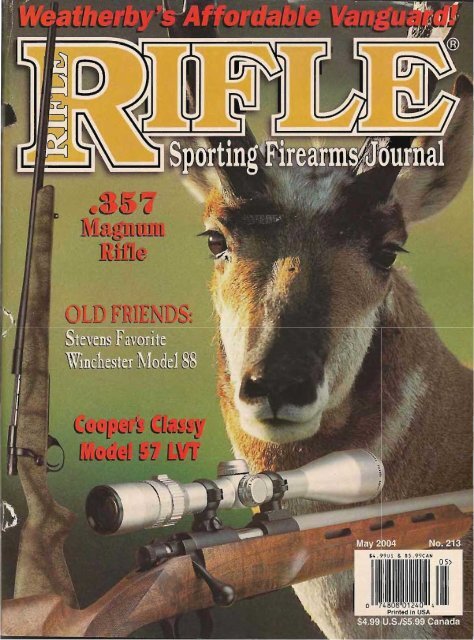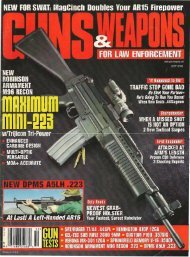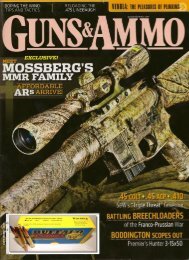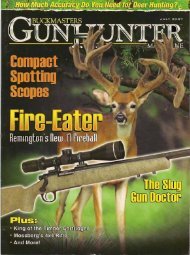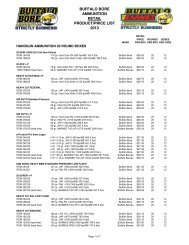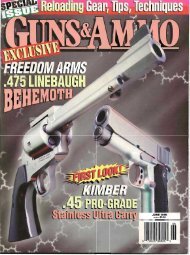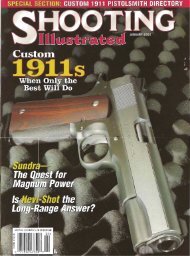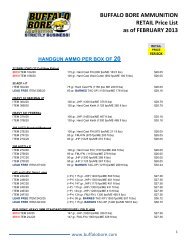Dangerous Game Cartridges - Buffalo Bore Forum
Dangerous Game Cartridges - Buffalo Bore Forum
Dangerous Game Cartridges - Buffalo Bore Forum
You also want an ePaper? Increase the reach of your titles
YUMPU automatically turns print PDFs into web optimized ePapers that Google loves.
DANGEROUS GAME CARTRIDGES ------------<br />
: Love your magazine. Could<br />
Q you guys do a study on the<br />
.45-70 in comparison to other dangerous<br />
game cartridges' Perhaps<br />
test the Garre t and <strong>Buffalo</strong> <strong>Bore</strong><br />
rounds against the .375 H&H or<br />
. 458 Winchester Magnum or LoU'<br />
If you check out many of the forums,<br />
you will see heated debates<br />
on this topic. Would be a great<br />
seller ror you guys and a great<br />
read for liS!!<br />
- C.AL., via Int.ernet<br />
the .45-70 in Africa, where he used<br />
a Cor-Bon 400-grain solid to shoot<br />
a Cape buffalo, whereupon the<br />
bullet exited the bull and killed a<br />
cow buffalo that had gone unnoticed<br />
on the other side of the bull .<br />
The bull took off, and Brian shot. it<br />
in the south pnd where the solid<br />
penetrated to the heart., ending<br />
the affair in fairly short fashion.<br />
So, it may be logical, from<br />
Brian's account., to assume the<br />
.45-70 is perfectly adeq uate foJ'<br />
Cape buffalo - assuming one is<br />
using a 400-grain solid at appl'oxi<br />
ITlately 1,800 fvs and the range is<br />
limited to 100 yards or less. Most<br />
folks would be tempted to ask<br />
whether Brian's hunt would have<br />
turned up similar results if he had<br />
A: Good idea, but the n'uth is,<br />
there is no comparison between<br />
the .45-70 and the .375 H&H, .458<br />
Winchester Magnum f .458 Loti ..<br />
And, at the risk of possibly inciting<br />
a riot on the Internet, I'll tell<br />
you why.<br />
Right off, I would imagine this<br />
"debate" is somewhat inspired by<br />
the stor-y Brian Pearce did about.<br />
6 www.ri{/emagazine.com<br />
1 2 3 4<br />
Anyone can hunt potentially<br />
dangerous game with the .45-70<br />
(1), but fighting cartridges like the<br />
(2) .458 Winchester Magnum,<br />
(3) .375 H&H and (4) .458 Lott are<br />
in a completely different class.<br />
used a 400-grain softnose. Either<br />
way, it's a bit of a stretch to compare<br />
Brian's load in the .45-70 to a<br />
300-grain solid at 2,400 fps from a<br />
.375 H&H, or a 500-grain solid at.<br />
2, 100 or 2,300 fps from the .458<br />
Wirrchester or Lott. U's plainly obvious,<br />
or should be, that t:he two<br />
.4:')8 belted cartridges pack a lot<br />
more clout t.han the .45-70, regardless<br />
of which performance criterion<br />
anyone migl1t choose, i .e.<br />
kinetic energy or Taylor's knockout<br />
formula.<br />
The comparison, Olen, should really<br />
address t.hese cartridges in<br />
terms of performance potential on<br />
large game, o}' at what point is a<br />
cart.ridge consic\ered adequate or<br />
acceptable in terms of producing<br />
a high percentage of one-shot kills<br />
on buffalo, lions or even elephant.<br />
Rifle 213
B,ullet Swaging<br />
Stuff<br />
Equipment, Information,<br />
Used & Surplus Gear<br />
An online at:<br />
www.rceco.com<br />
RCE Co" 4090 Colver Rei,<br />
Phoenix, OR 97535<br />
Tel: 1-541 -512-0440<br />
Fax: 1-541-5 J 2-9433<br />
E-Mail fce-incl@juno.com<br />
WORLO'S FINEST PRODUrCTlON'<br />
RIFLE BARRELS<br />
~LAS<br />
UL TRARIFLED<br />
BARRELS IN MOST SIZES,<br />
SHAPES AND CALIBERS.<br />
. Stainless steel or chrome' moly'<br />
-AFFORDABLE aUALlTY-<br />
Wrile (0' tree information to'<br />
DOUGLAS BARRELS, INC.<br />
" 5504 Big Tyler Rd" RM5 :;c - -<br />
.j Charleston, WV 25~ 13 VIS( I<br />
• _' _ 304-nli-1341 FAX 304-776-8560 '<br />
eo<br />
llJRNINg Oll9'RE9 INTO<br />
U,I ITY<br />
(7 19] 667- 1090<br />
VIVoJW 11f'( IJ~.lj·H'l~ • ... (11"1<br />
Obviously, the performance evaluation<br />
has to include bullets, softnoses,<br />
solids or whatever, like the<br />
X-Bullet. If we restric t the dialogue<br />
to softnose bullets, the .45-<br />
70 with a 400-grain Kod ia 1< or<br />
Hawk with a .050-inch jacket is<br />
probably acceptable for Cape buffalo,<br />
assuming proper blllleL placement.<br />
That also applies to the ,375<br />
H&H with a Swift A-Prame or<br />
NosIer Partition. Bllt, no matter<br />
how you cut it, a 500-graill, .468-<br />
inch bulleL at 2,000 fps impact velocity<br />
delivers a tremendous blow,<br />
even on soft body shots. The same<br />
could be said of the .470 NE or the<br />
.404 .Jeffery and .416 Higby or<br />
Remington Magnum. All assuming,<br />
of course, the bullet is up to<br />
the job at hanet.<br />
I'm also reminded that there arc<br />
hunting cartridges and fighting<br />
cartridges, the latter being those<br />
that: are required to adminisLer a<br />
one-shot st.op in a fight that wa"<br />
started with a .375 H&H, for instance.<br />
So, while it may be possible<br />
to stop an enraged four-footed<br />
a,ntagonist with a .45-70, the .458<br />
LotL and .470 NE are superior<br />
tools for the job.<br />
Then there's an experience my<br />
friend Martin Pieters recounted<br />
one evening as we lounged around<br />
the campfire in the Okavango last<br />
August:. It seerns one of his cUents<br />
wounded a. Cape buffalo, and th(~y<br />
f;'li1(~ d to find it hefore the client<br />
had to leave. So, Martin went back<br />
out and spent two days searching<br />
tlu'ougn a little less than 2,000 buffalo<br />
before he found the wounded<br />
bull, which promptly took exc-clr<br />
lion to M.artin's intl'\lsion and<br />
charged. Martin responded wi th a<br />
SOO-grain .470 solid, between the<br />
eyes, ancl the bull fell dead at his<br />
feel. He would have tri ed the<br />
frontal hf~ ali shot, but the bull was<br />
so close that thE;' angl e was nol<br />
right. The effect, no doubt, would<br />
have been the same had Martin<br />
used a GOO-grain solid in th e .458<br />
Lott or .458' Winchester l'VlagtlUJ,T\<br />
or 400-gra.in solid in the .416 Rigby<br />
or Hemington Magnum.<br />
It might also be claimed the .45-<br />
70 \.'lith a 500-grain solid would<br />
have stopped thaT, bull as well, bnt<br />
it should be plainly obvious that if<br />
one is to error in cartridge selectioll<br />
for such work, it is best to<br />
elTor 011 the heavier side. At that,<br />
there ill'e countless hOl1'or stories<br />
of Cape buffalo taking multiple<br />
hi ts from .458 Wincheste rs or<br />
.470 NE doubles, or combinations<br />
r,hereof, b(~ fort' giving up or<br />
stomping on some llnfortunate<br />
soul's body parts. There is even a<br />
well-documented episode where a<br />
huge Cape buffalo took a 400-<br />
grain ,bullet through the heart<br />
from a .404 Jeffel)', and it waited<br />
in ambush for 30 minutes, at<br />
which time the hunter approached<br />
and the bull got up and charged,<br />
receiving another slug in the eye<br />
at spitting distance.<br />
So, it's not adequate to address<br />
the problem of how carLridges<br />
might compare in normal hunting<br />
sit uations. It is only when the<br />
worst: possible scenario is considered<br />
that tIle wheat is clearly separated<br />
from the chaff.<br />
The point of all t his is that we<br />
could argue La th€ point of reductio<br />
ad absurdum as to whether<br />
or not the ,45-70 is the equal of<br />
other, more established dangerous<br />
gante caJtridges. But it is i11\<br />
pOltant t:O keep in mind that the<br />
animal is only dangerous if t.he situation<br />
is screwed up or gets out oJ<br />
han(!. So, let's consider, hypothetically,<br />
if the bull Brian shot turned<br />
the other way and came back at<br />
them. All of a sudden, lhe lables<br />
have turned, and the animal becomes<br />
a selioos threat. Would the<br />
.45-70 with a 400-gl'ain solid at<br />
1,800 fps be enough to stop the<br />
bull before it hooks a horn into<br />
someone<br />
I'm also mindiul of the fact the<br />
most vocal critics of any C
WALNUT GUN STOCK BLANKS<br />
From Tree to Sawmill to You - No Middleman<br />
FREE Brochure • Visit our Web site:<br />
clarowalnutgunstocks.com<br />
CLARO WALNUT GUNSTOCK CO.<br />
1235 Stanley Av~ .• Chico, CA 95928<br />
Phone: (530) 342-5188 • F.ax: (530) 342-5199<br />
- Since 1949 -<br />
Still cleaning the old smelly, messy way<br />
Why ... When there is the 10SSO way!<br />
The IOSSO <strong>Bore</strong> Cleaning System<br />
was developed (or the most meticulous shooter. qeaning is<br />
done effortlessly, in 15 minutes or less with no smell, and<br />
no running or splattering of fluids.<br />
105S0 <strong>Bore</strong> Cleaner removes:<br />
• powder fouling and carbon burn<br />
• copper, lead, moly<br />
• plastic wad<br />
• surface rust<br />
105S0 Gun Oil:<br />
• removes loose residues<br />
• removes 111 issed dea ning residues<br />
• inhibits corrosion<br />
• lubriC3les<br />
Polished Peljection!<br />
For a special priced trial order,<br />
call toll free 1-888-747-4332<br />
IOSSO~ PRODUCTS<br />
1485 Lively Boulevard. Elk Grove, Il 60007 • vIWW.iosso.Go]T1<br />
Hill Country Rifle Co.<br />
)726 Morningside Drive<br />
New Braunfels. TX 781.32<br />
830-609-J J 39<br />
www.hillcQllntryri!1es.co.m<br />
~.<br />
Semi-Custom Rifles<br />
""Will Model 70 or Rem 700<br />
Stainless Steel Factory Rifle<br />
~'McMillan Fiberglass Stock of Choice<br />
*Pachmayr Decelerator Pad<br />
"'HCR Accm'izing and Barrel Break In<br />
*Guaranteed Sub-Inch Groups with Factory Ammo!!!<br />
Let's face it. The factory "Custom Shop" rifles don', live up Ie) what a true<br />
custom shop shoulc1 del iVer and the regular factory synthetic stocks are junk.<br />
We will detiver a completely accurized rine, pmar bedded in a McMillan<br />
stock, with guaranteed. consi stent accuracy using quality factory ammo for<br />
$1495.00 (magnum calibers add $50.00). We will offer the same package on<br />
your existing rifle for $795.00.<br />
"'*"NEW Hill O .)lJlltry Classic Stock for Winchester Model 70 add $100.00*"*<br />
10 www.ri{lemagazine.com<br />
black-powder cartridge takes on<br />
an entirely different personality.<br />
(Hornady lists lo~.c1s for its 500-<br />
grain solid at 1,800 fps ill t.he .45-<br />
70 Ruger No. \.) The same could<br />
be said for the .450 Marlin, .450<br />
AJaskan, .45-90 WCF and, to SOlne<br />
degree, smokeless loads in the .50-<br />
100-450 in modern rines. There's<br />
even the .50 AJuskan to consider,<br />
especially when it tosses 450-grain<br />
buBers around at a bit over 2,000<br />
fps from all 18,[~-inch barrel and<br />
535-grain bullets at 1,BoO fps I'rom<br />
a 2fi-illCh tube. These .60 Alaskan<br />
<strong>Buffalo</strong> <strong>Bore</strong> loads are creeping<br />
right up on the ,458 Winchester<br />
Magnum.<br />
I've used all t.he al)ove, except<br />
the .450 Marlin, to take deer-sized<br />
game, elk and bears, and 1 wonlc!<br />
be harel pressed to distillguish the<br />
end result produced by any of<br />
them from thl:' rest - where the<br />
right bullet is used for the task at.<br />
hane!. If you really want to confuse<br />
!lIe issue, I'll toss in the .50<br />
Black Powder Express used in<br />
Africa on Cape buffalo and plains<br />
game. and the .50-90 Sharps used<br />
OIl bison, deer and elk - all .50-caliber<br />
loads usjng black powder, of<br />
COLll'se,<br />
Somet.imes I wonder if we m:en't<br />
just arguing death by degree, e.g.,<br />
a 400-grain solid at 1,800 fps from<br />
a .45-70 is adequate for whatever,<br />
but. the sallle hullet at. 1,550 fps is<br />
Uttle nlOl'e than a l'eceipe for (bsmal<br />
failure. Where does that bullet<br />
downgrade from "perfectly adequate"<br />
to "mru:gina!" or "inadequate"<br />
- 1,400, 1A50 or 1,500 fps'<br />
I'm also aware t.hat a lot of folks<br />
like to ha.ve things t.ied up in a Licly<br />
little package in terms of kinetic<br />
energy or Taylor's K-O values, but<br />
you may rest assured, it isn't. ti1at<br />
easy. Big, heavy bullets usually<br />
perform all out of proportion to<br />
their paper l1urnbers. The bison I<br />
shot SOl\le time back .Yie~ded 892<br />
pounds of boned meaL, sornething<br />
over a ton on the hoof, and it went<br />
to i.ts knees within seconds after<br />
receiving a 535-grain cast bullet at<br />
±200 yards, where VE: locity had<br />
dropped to Ii tt.le more than 900<br />
fps. Seeing the snow fly on the<br />
ot.her side of tbe beast., it. ap-<br />
Rifle 213
peru'ed the bullet didn't even slow<br />
down on the way through, leaving<br />
huge holes in both lungs and<br />
shattering ribs on the way in and<br />
out. Who would have guessed<br />
One thing we know for sure, any<br />
attempt to evaluate cartridge/<br />
bullet performance of these bigbore/heavy<br />
bullet cartridges using<br />
the same criterion commonly associated<br />
with .30, .338 and .375<br />
bores (Le. high velocity and energy<br />
numbers) will usually lead to<br />
nothing but frustration and/or<br />
self-inflicted psychosis.<br />
So, what about the debate comparing<br />
the .375 H&H, etc" etc<br />
Rest assured, it will rage on, fostered<br />
on both sides by criLics who<br />
would never dream of using a .45-<br />
70 on anything, let alone a Cape<br />
buffalo, and big-bore fanatics who<br />
claim any bullet at less than 2,000<br />
fps that generates anything less<br />
thrut 5,000 foot-pounds at the muzzle<br />
is doomed to failure on rulY animallarger<br />
than a 40-pound diker.<br />
This reminds me of a reader who<br />
asked which of two cast bullets -<br />
an RCBS .45-270 SAA (SWC) or<br />
LBT WFN - of equal weight at the<br />
same velocity had superior killing<br />
power on hogs or deer-sized<br />
game. I suggested il would be a<br />
tossup, but the WFN might kill the<br />
animal deader than the RCBS bullet<br />
would, Then too, I couldn't<br />
prove it because, to my knowledge,<br />
there is no scale of "relative<br />
deadness." That is, where a 1<br />
would be just "dead" and 2 would<br />
be "deader," 3 would be "stone<br />
dead" and so on. Comparing the<br />
.45-70 t.o a .375 H&H nlight create<br />
an inspired debate on the scale of<br />
deadness, where the .458 Lott<br />
would rate a 9 or 10, "stone cold<br />
dead" or "dead 'n buried." This<br />
could get outta har d.<br />
(,j)<br />
~~ert~!~l!,~;,wndl<br />
P.o . Box 25. D.yron. WY 82836 ii1!11!iiPQ~!iiiiiii<br />
Depl. 11 • (307) 655·9314<br />
•••••<br />
Custom Rifle Metalwork<br />
Shown he,,,, RIDS (;. RINGS<br />
We offer fine q '~arle( , ribs and<br />
rings. grip caps. bah handles. boll stops. Mannlicher foreend<br />
tips. flexible ramrods. special· order scofX! bases and<br />
olhi2J custom metalsmithing.<br />
Th.e Montana Plains ... a.n<br />
Royal Arms - Depl. II<br />
919 8!h A\'c. NW, Great falls. MT 59404<br />
Tel: (406) 4)3·1149 Fax: (406) 45.\· 1194<br />
Websile: itllp:llwww.inll.netl-roy:lIanns· No E,M~il,please!<br />
Quality. Unfinished<br />
G!lostocks fronl<br />
l'ineWootl.<br />
Send $1 for QI;i\og<br />
& price lis!.<br />
Zambia·Zimbabwe·Soutb<br />
rica·Mauritius<br />
Hunt Specials for 2004<br />
~·IOdays Elephal"llall inel. for 510,950.<br />
7 days Plains <strong>Game</strong> 2xl for$4,495: Gre .. ter Kudu,<br />
Livingstone's Eland. Blue Wildebeest, Zebra. Impala.<br />
Warthog. Duikcr, Steenbok, J~ckal. Baboon.<br />
Gumnteed LeopudL· 10 days $8.900<br />
Cape Buff~· 7 days Ixl<br />
$7.900 (Zimbnbwe) $8,500 (Zambia)<br />
Kelly's Africa Pvt. Ltd.<br />
uu:w.kellysafrica.rom e·mlJ/1: keJlyfact,{§MI.com<br />
Ph & FAX (303) 646·3076 Cell24n (303) 57(1..6950<br />
May-June 2004<br />
www_riflemagazine.com 11
Compact power and accuracy.<br />
The most common rifles encountered<br />
are handy American-made<br />
lever actions from Marlin, Winchester<br />
and replicas of the Winchester<br />
Models 1873 and 1892 that<br />
are generally produced by foreign<br />
manufacturers. These represent<br />
[he majority of .357 Magnumchambered<br />
long guns in tile hands<br />
of shooters. There are, ho",,'ever,<br />
several single-shot rines that have<br />
been offered periodically, including<br />
the Ruger No. I, Browning<br />
\Iodel 1885 and economically<br />
priced break open actions from<br />
Harrington & Hichardson and New<br />
England FIrearms. A variet.y of<br />
combination guns have been offered<br />
in this caliber, but leverguns<br />
are by far the most common.<br />
Of the many .357 leverguns<br />
around, the Marlin Model 1894 is<br />
58 www.rif/emagazine.com<br />
~357MAG.<br />
rl 158 GR • .IACKrnD SOFT POINT<br />
HUIffiIIa<br />
1
I<br />
wwu rill m yazl, e.com 59
Miero-Groove" rliling,<br />
so a few rernarks<br />
;;. about these barrels<br />
"""-II' ~YJ seem appropriate.<br />
'7 This rifling system has<br />
been the victim of vicious<br />
rumors, lea\>ing some owners with<br />
I.he impression they are lousy for<br />
east bullets. Several times I have<br />
visited with Micro-Groove owners<br />
who claimed their guns wouldn't<br />
shoot cast. bullets, but when they<br />
were quizzed on specific loads,<br />
they admitted they had never tried<br />
them but had been told I.hey<br />
wouldn't work. This is unfOliunate<br />
as the Micro-Groove rifling has the<br />
potential to be one of the best barrels<br />
for lead bullets, as distortion is<br />
mil~or, yet the barrel holds the bullet<br />
firmly. (Marlin rifles charnbered<br />
in .22 LR and featuring the same<br />
Iif1ing have a Eeputation for good<br />
accLIl"acy with lead butlets.)<br />
Granted some Marlin .3575 shoot<br />
cast bullets well, while others are<br />
not. so good. Several factors can affect<br />
how they perform, but the<br />
, most common accuracy thIef can<br />
usually be traced to the rather<br />
abrupt leade from the chamber<br />
into the rifling. Heclltting this leade<br />
to 1 %i degrees usually improves accura.cy,<br />
Also, some Micro-Groove<br />
barrels are a bil rough, and fire<br />
lapping may be necessary to gel<br />
them to perform up to snuff with<br />
The ,357 Magnum cartridge is popular with cowboy action shooters in<br />
leverguns and single-action revolvers, but it's a.lso useful tor hunting and<br />
defense. Here we have a Browning Model 92, a 2nd generation Colt Single<br />
Adion and a Smith & Wesson Model 66.<br />
cast bullets. Yor those who shoot:<br />
jacketed bullets, the Micro-Groove<br />
rining is generally accurate right<br />
out of the box, but the above "tuneup"<br />
procedure usually proves beneficial<br />
fot" them as well.<br />
The Ballard rifling was brought<br />
back because of the tl'end toward<br />
cast bullets among shooters.<br />
hunters and cowboy action competitors,<br />
It gives good accuracy<br />
with any reasonable bullel but also<br />
gives out.,tanding results with jacketed<br />
versions. 1 hav
of the pickup, serving as a backup<br />
should something go awry with<br />
Susan's pr imary r ifle, a scoped<br />
7x57mm Maus er. She had been<br />
shooting the Browning regularly in<br />
casual practice or plinking sessions<br />
and cOl,lld hit very well with<br />
it at 75 t.o 100 yards offhand.<br />
A Browning Model 92<br />
would consistently<br />
gloup alound one inch<br />
at 75 yards.<br />
Slow-burning magnum handgun powders offer top performance in .357<br />
\.1agnum hand/Dads.<br />
Lil
~ ~~. sight of the deer first,<br />
": ~ ~ so just settled in the<br />
. sagebmsh and waited<br />
fill' i::!/ for my wife to ge t<br />
~ C ( ~ into position and attemp\'<br />
to take he r first<br />
deer. (Even though season was<br />
open for either sex, I suggested<br />
she take a doe to allow the young<br />
buck to grow up.) She hat! a per<br />
[eel broadside shot at something<br />
around 60 estimated yards, anel r<br />
was in the unique posit.ion to see<br />
the shot. fired with the doe facing<br />
me . The Speer bullet struck the<br />
shoulder and exited the other side,<br />
which put the deer down instantly.<br />
She managed to get up and take a<br />
couple wobbly steps then went<br />
down and exp.ired.<br />
Today's jacketed bullets<br />
are much better than<br />
any previous designs.<br />
The wound chanJ1el was remarkable<br />
for such a small caltridge, anel<br />
to avoid controve rsy I will not<br />
compare it to other deer rounds.<br />
But let's just say it was impressive<br />
for such a small cartridge , and I<br />
had a ne w r espect fol' Lhe .357<br />
Magnum when fired from a rifle.<br />
Most .357 Magnum lever-action rit7es will function best if the overall cartridge<br />
lengfh is kept to less than 1.605 inches.<br />
Since the above deer hunt, I have<br />
observed first-hand, or llsed myself,<br />
the .357 Magnum rifle on additional<br />
mule deer, black bear and<br />
considerable SInal! game including<br />
raccoons, skunks, beaver, badger<br />
and a ha.ncU'ul of coyotes that were<br />
called within ISO yards. As long as<br />
the right bullets are use d, the<br />
above perfonl1-l!.<br />
t.en!. while living in a remote<br />
wilderness area of the southeastern<br />
U.S. in the early 19705. He<br />
pra.ised its versatility and handi<br />
IH~ sS but also commented it was<br />
the "darndest killer for a sm all<br />
cased cartridge in a rifle he had<br />
ever seen." This man has hunt.ed<br />
all over the world, lived and<br />
hunted in JUrica for several years<br />
and has gained a wealth of knowle<br />
dge of guns, bullets anel cartl"idges.<br />
My friend also reported giving a<br />
c onverted Model 92 .3!")7, a.long<br />
with a supply of handloads using a<br />
140-grain cast SWC (SAECO) bullet<br />
a t 2,000 ips with a suitable<br />
charge of Hercule s ,2400, to a<br />
friend of his who lived in the same<br />
remote area. One eV(~ ning while<br />
t.aking a walk, an old sow black<br />
bear charged him, and he managed<br />
to kill it instantly wit.h a properly<br />
placed bullet from the .;357 rifle at<br />
jllst a few feel.. The bear's moment.um<br />
knocked him down, ,and the<br />
bear landed on him .. The .357 is not<br />
my choice if I were faced with an<br />
angry b (-~ ar, but a cOITectly placed<br />
bullet certainly did the job.<br />
Other uses for the .357 Magnunl<br />
levergun include home defense Or<br />
for travelers crossing stat.es that,<br />
prohibit non-residents frorn carlYing<br />
a handgun in the ve hicle. If a<br />
little time is spent learning defensive<br />
handling tec hniques, it is a<br />
highly effective tool, as it delivers<br />
substantially greater power than<br />
the revolver, is easy to shoot accurately<br />
an.d recoil is modest, allowing<br />
for fast follow-up shots.<br />
Most experienced levergun<br />
shooters can usually plan' 10 shots<br />
into the "vitals" of a 827 man tar-<br />
Rifle 213
get at 30 feel in 4 to 6 seconds<br />
using full-power magnum ammuni<br />
(ion, Those with advanced skills<br />
and good strength can place three<br />
shots inl.O the "vital" area in<br />
around one second at across-theroom<br />
distances. More important I<br />
have observed individuals with<br />
only a "modest." level of rille shooling<br />
skUl clear a variet.y ot'steel targels<br />
in less time with a lever-action<br />
rif1e or carbine than t.hey could run<br />
the same course with a revolver, or<br />
even an autoloading pistol. And<br />
they are hitting the target witl) notably<br />
Inore power. (A seasoned<br />
handgun shot can easily exceed<br />
these times.)<br />
Some cowboy competitors have<br />
been reported to run 10-shot<br />
strings on a 12-inch steel plate at<br />
12 yards in 2.5 to 3 seconds, but<br />
lIsing ultralight .38 SpeCial ammunition<br />
rather than full-power magnum<br />
loads and in leverguns thal<br />
have been Luned and short-stroked<br />
specifically for speed shooting, (At<br />
another Hme we will discuss some<br />
of the custom work that can be<br />
done to leverguns to improve them<br />
for personal defense thal includes<br />
speed shooting-t.ype sight.s, light<br />
bars, lasers, action work and takedowns.<br />
At the least, most rilles will<br />
likely need minor action or lllne-up<br />
work to assure reliable feeding<br />
when quickly running the action.)<br />
Over the years I have known several<br />
law enforcement personnel<br />
who have used a .357 Magnum levergun<br />
for dispatching wounded<br />
game and liveslock that had been<br />
injured by vehicles and in finishing<br />
gunfights wit.h felons. The effectiveness<br />
of these little guns cannot<br />
be overstated.<br />
FAVORITE BULLETS AND Lo illS<br />
I like cast bullels in .357 Magnum<br />
rines, as they are inexpensive lo<br />
produce, easy on bores and, if designed<br />
with a flat. nose, produce remarkabk<br />
shock and penetration<br />
on game anel are rarely recovered<br />
on deer or black bear, The olles I<br />
have usee! most include Lyman<br />
mould 358156 in bOlh solid and<br />
hollowpoinl configurations with a<br />
gas check. Some guns will give<br />
good results with the RCBS 150-<br />
KT, which usually casts around 155<br />
Savage J7 liMR R.in:es<br />
tv :J ,-<br />
Leading tHe market ia tfli- popular caliber<br />
The introduction of rhe 17 HMR caliber crearcd an<br />
LUlprcceciemC!'.ci d~manJ. Savage respondcd by offering<br />
more models chmnbered in rhis caliber rhan
GARY L. STILES<br />
Gunmaker<br />
. Specializing in ClassIc Boll Action Rifles·<br />
• Safely conversions for Ma\lsets & Spnngfields •<br />
• Ouartet Ribs. Cheokered Boll Handles'<br />
. Complele Rilies . Pnces Upon Requesl .<br />
76 Cherry Run 'Road, Homer City, PA 15748<br />
Phone (724) 479·9945 or 479-8666<br />
Learn Gunsmithing<br />
8AASOegree<br />
®1-q::e~[C\<br />
~ 1-800-922-6787<br />
, ext. 7925 or 2348<br />
email: alanJohr@yc.edu<br />
For Mo.relnformation:<br />
www.gunsmithing.org<br />
Vavana i 1100 E. Sh('lclon 51<br />
, • r,'OttEC'r Prescott. AZ. 86301<br />
C I. wWNyc.edu<br />
Your wmmunll'y lvur C.\..lUCSC'<br />
S<br />
ine,' 1f)54 •.• w/Jetller YDu're whi5UiDg ,<br />
' Olxie" or 'Yankee Dood/c· ... lh" Dixie<br />
Gun Work-~' catalog has been A MUST ror<br />
.m)' blackprnvc1er enthusiast or histOr.)' buff.<br />
r(~ ( \ ely (he mo-;t comprehensive source of<br />
bl~' J
- Thermometers -; Furnace Kits I<br />
- Rowell Ladles - Casting Pots<br />
• Mould Release • LETS Flux<br />
WI: \'IIWI Iheantimonym an rom · \'iww.Qulletmelals,con1 :.<br />
~ Bill hrg.son , PO Sex i238, Sierra Visl" lIZ 85636<br />
~ TEl (521)\ 45e'5221 ri


